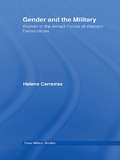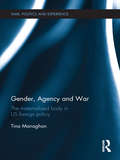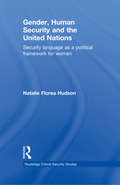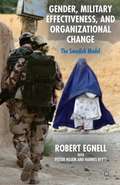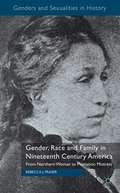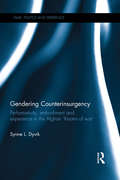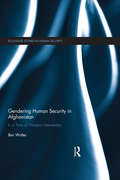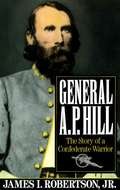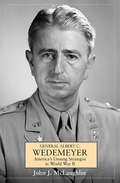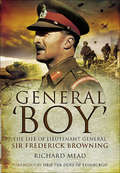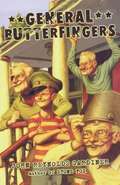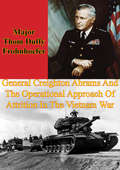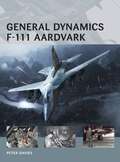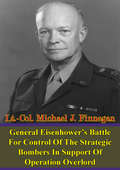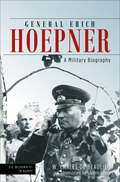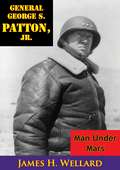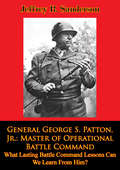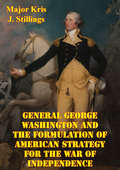- Table View
- List View
Gender and the Military: Women in the Armed Forces of Western Democracies (Cass Military Studies)
by Helena CarreirasThis is the first comparative, cross-national study of the participation of women in the armed forces of NATO countries. Along side an analysis of this key topic stands a critique of existing theoretical models and the proposal of a revised analytical framework. Unlike previous works this new study employs mixed-methodological research design combining quantitative and qualitative data - a large N-analysis based on general policies and statistical information concerning every country in the sample with more in-depth case-studies. This volume includes original empirical data regarding the presence of women in the armed forces of NATO countries, proposes an index of ‘gender inclusiveness’ and assesses the factors that affect women’s military roles. The book also presents two new key case studies – Portugal and the Netherlands - based on both documentary sources and in-depth interviews of both men and women officers in the two countries. This book will be of great interest to all students and scholars of strategic studies, gender and women studies and military history.
Gender, Agency and War: The Maternalized Body in US Foreign Policy (War, Politics and Experience)
by Tina ManaghanThis book traces practices of militarization and resistance that have emerged under the sign of motherhood in US Foreign Policy. Gender, Agency and War examines this discourse against the background of three key moments of American foreign policy formation: the anti-nuclear movement of the 1980s, the Gulf War of the early 1990s, and the recent invasion of Iraq. For each of these moments the author explores the emergence of a historically specific and emblematic maternalized mode of female embodiment (ranging from the ‘hysterical’ antinuclear protester to the figure of ‘Supermom’), in order to shed light onto the various practices which define and enable expressions of American sovereignty. In so doing, the text argues that the emergence of particular raced, gendered, and maternalized bodies ought not to be read as merely tangential to affairs of state, but as instantiations of global politics. This work urges an approach that rereads the body as an ‘event’ – with significant implications for the ways in which international politics and gender are currently understood. This book will be of much interest to students of gender politics, critical security studies, US foreign policy and IR in general.
Gender, Human Security and the United Nations: Security Language as a Political Framework for Women (Routledge Critical Security Studies)
by Natalie Florea HudsonThis book examines the relationship between women, gender and the international security agenda, exploring the meaning of security in terms of discourse and practice, as well as the larger goals and strategies of the global women's movement. Today, many complex global problems are being located within the security logic. From the environment to HIV/AIDS, state and non-state actors have made a practice out of securitizing issues that are not conventionally seen as such. As most prominently demonstrated by the UN Security Council Resolution 1325 (2001), activists for women's rights have increasingly framed women's rights and gender inequality as security issues in an attempt to gain access to the international security agenda, particularly in the context of the United Nations. This book explores the nature and implications of the use of security language as a political framework for women, tracing and analyzing the organizational dynamics of women's activism in the United Nations system and how women have come to embrace and been impacted by the security framework, globally and locally. The book argues that, from a feminist and human security perspective, efforts to engender the security discourse have had both a broadening and limiting effect, highlighting reasons to be sceptical of securitization as an inherently beneficial strategy. Four cases studies are used to develop the core themes: (1) the campaign to implement UN Security Council Resolution 1325; (2) the strategies utilized by those advocating women's issues in the security arena compared to those advocating for children; (3) the organizational development of the UN Development Fund for Women and how it has come to securitize women; and (4) the activity of the UN Peacebuilding Commission and its challenges in gendering its security approach. The work will be of interest to students of critical security, gender studies, international organizations and international relations in general. Natalie Florea Hudson received her PhD in Political Science from the University of Connecticut and is an Assistant Professor at the University of Dayton. She specializes in gender and international relations, human rights, international security studies, and international law and organization.
Gender, Military Effectiveness, and Organizational Change
by Robert Egnell Petter Hojem Hannes BertsThrough extensive analysis of the Swedish Armed Forces this study explores the possibilities and pitfalls of implementing of a gender perspective in military organizations and operations. It established a number of important lessons for similar attempts in other countries and discusses the continued process of implementation in the Swedish military
Gender, Power, and Military Occupations: Asia Pacific and the Middle East since 1945 (Routledge Research in Gender and History)
by Christine De Matos Rowena WardMilitary occupations and interventions have a gendered impact on both those engaged in occupying, and those whose lands have been occupied. Yet little is known about this gendered impact, in terms of both masculinities and femininities, either historically or in contemporary times. While research in this area has begun to grow since events in Iraq and Afghanistan, this collection helps redress the relative neglect by examining and analysing the impact of occupation on men and women, both occupied and occupier, in a variety of geographical spaces from Japan to Palestine to Iraq. Gendered perspectives are also intimately tied to analyses of ‘power’: how power is enacted by the occupier; how powerlessness is experienced by the occupied; how power is negotiated, shared, compromised, subverted, reclaimed; power as visible and invisible; institutional power; contested power in post-conflict societies; and power as discursively constructed. The term ‘military occupation’ is interpreted broadly to include occupation, interventions, the presence of military bases and peacekeeping/post-conflict operations. This interpretation allows space to demonstrate that the lines between each definition are blurred, especially when it comes to analysing gender and power.
Gender, Race and Family in Nineteenth Century America: From Northern Woman to Plantation Mistress (Genders and Sexualities in History)
by Rebecca J. FraserSarah Hicks Williams was the northern-born wife of an antebellum slaveholder. Rebecca Fraser traces her journey as she relocates to Clifton Grove, the Williams' slaveholding plantation, presenting her with complex dilemmas as she reconciled her new role as plantation mistress to the gender script she had been raised with in the North.
Gender, War, and World Order: A Study of Public Opinion (Cornell Studies in Security Affairs)
by Richard C. EichenbergMotivated by the lack of scholarly understanding of the substantial gender difference in attitudes toward the use of military force, Richard C. Eichenberg has mined a massive data set of public opinion surveys to draw new and important conclusions. By analyzing hundreds of such surveys across more than sixty countries, Gender, War, and World Order offers researchers raw data, multiple hypotheses, and three major findings.Eichenberg poses three questions of the data: Are there significant differences in the opinions of men and women on issues of national security? What differences can be discerned across issues, culture, and time? And what are the theoretical and political implications of these attitudinal differences? Within this framework, Gender, War, and World Order compares gender difference on military power, balance of power, alliances, international institutions, the acceptability of war, defense spending, defense/welfare compromises, and torture. Eichenberg concludes that the centrality of military force, violence, and war is the single most important variable affecting gender difference; that the magnitude of gender difference on security issues correlates with the economic development and level of gender equality in a society; and that the country with the most consistent gender polarization across the widest range of issues is the United States.
Gendered Wars, Gendered Memories: Feminist Conversations on War, Genocide and Political Violence (The Feminist Imagination - Europe and Beyond)
by Ayşe Gül AltinayThe Introduction of this book is freely available as a downloadable Open Access PDF under a Creative Commons Attribution-Non Commercial-No Derivatives 4.0 license available at http://www.taylorfrancis.com/books/e/9781315584225 The twentieth century has been a century of wars, genocides and violent political conflict; a century of militarization and massive destruction. It has simultaneously been a century of feminist creativity and struggle worldwide, witnessing fundamental changes in the conceptions and everyday practices of gender and sexuality. What are some of the connections between these two seemingly disparate characteristics of the past century? And how do collective memories figure into these connections? Exploring the ways in which wars and their memories are gendered, this book contributes to the feminist search for new words and new methods in understanding the intricacies of war and memory. From the Italian and Spanish Civil Wars to military regimes in Turkey and Greece, from the Armenian genocide and the Holocaust to the wars in Abhazia, East Asia, Iraq, Afghanistan, former Yugoslavia, Israel and Palestine, the chapters in this book address a rare selection of contexts and geographies from a wide range of disciplinary perspectives. In recent years, feminist scholarship has fundamentally changed the ways in which pasts, particularly violent pasts, have been conceptualized and narrated. Discussing the participation of women in war, sexual violence in times of conflict, the use of visual and dramatic representations in memory research, and the creative challenges to research and writing posed by feminist scholarship, Gendered Wars, Gendered Memories will appeal to scholars working at the intersection of military/war, memory, and gender studies, seeking to chart this emerging territory with ’feminist curiosity’.
Gendering Counterinsurgency: Performativity, Embodiment and Experience in the Afghan ‘Theatre of War’ (War, Politics and Experience)
by Synne L. DyvikThis book analyses the various ways counterinsurgency in Afghanistan is gendered. The book examines the US led war in Afghanistan from 2001 onwards, including the invasion, the population-centric counterinsurgency operations and the efforts to train a new Afghan military charged with securing the country when the US and NATO withdrew their combat forces in 2014. Through an analysis of key counterinsurgency texts and military memoirs, the book explores how gender and counterinsurgency are co-constitutive in numerous ways. It discusses the multiple military masculinities that counterinsurgency relies on, the discourse of ‘cultural sensitivity’, and the deployment of Female Engagement Teams (FETs). Gendering Counterinsurgency demonstrates how population-centric counterinsurgency doctrine and practice can be captured within a gendered dynamic of ‘killing and caring’ – reliant on physical violence, albeit mediated through ‘armed social work’. This simultaneously contradictory and complementary dynamic cannot be understood without recognising how the legitimation and the practice of this war relied on multiple gendered embodied performances of masculinities and femininities. Developing the concept of ‘embodied performativity’ this book shows how the clues to understanding counterinsurgency, as well as gendering war more broadly are found in war’s everyday gendered manifestations. This book will be of much interest to students of counterinsurgency warfare, gender politics, governmentality, biopolitics, critical war studies, and critical security studies in general.
Gendering Human Security in Afghanistan: In a Time of Western Intervention (Routledge Studies in Human Security)
by Ben WalterThis book employs the concept of human security to show what the term means from the perspective of women in Afghanistan. It engages with a well-established debate in academic and policy-making contexts regarding the utility of human security as a framework for understanding and redressing conflict. The book argues that this concept allows the possibility of articulating the substantive experiences of violence and marginalisation experienced by people in local settings as well as their own struggles towards a secure and happy life. In this regard, it goes a long way to making sense of the complex dynamics of conflict which have confounded Western policy-makers in their ongoing state-building mission in Afghanistan. However, despite this inherent potential, the idea of human security still needs refinement. Crucially, it has benefitted from critical feminist and critical social theories which provide the conceptual and methodological depth necessary to apprehend what a progressive ethical program of security looks like and how it can be furthered. Using this framework, the work provides a critical reconstruction of the effect of the US-led Western Intervention on women’s experiences of (in)security in the three provincial contexts of Nangarhar, Bamiyan and Kabul. This reconstruction is drawn from a wealth of historical and contemporary sociological research alongside original fieldwork undertaken in Delhi, India, during 2011 with women and men from the country’s different communities. This book will be of much interest to students of human security, state-building, gender politics, war and conflict studies and IR in general.
General A. P. Hill: The Story of a Confederate Warrior
by James I. Robertson Jr.A Confederate general who ranks with Lee, Jeb Stuart, and Stonewall Jackson but whose achievements have been unfairly neglected until now, finally receives his due in this invaluable biography by a noted historian of the Civil War. Drawing extensively on newly unearthed documents, this work provides a gripping battle-by-battle assessment of Hill's role in Antietam, Fredericksburg, Gettysburg, and other battles.
General Albert C. Wedemeyer
by John J. MclaughlinLike many heroes of the Second World War, General Albert C. Wedemeyer's career has been largely overshadowed by such well-known figures as Marshall, Patton, Montgomery, and Bradley. Wedemeyer's legacy as the main planner of the D-Day invasion is almost completely forgotten today, eclipsed by politics and the capriciousness of human nature. Yet during America's preparation for the war, Wedemeyer was the primary author of the "Victory Program" that mobilized US resources and directed them at crucial points in order to secure victory over the Axis. In the late 1930s, he had the unique experience of being an exchange student at the German Kriegsakademia, the Nazis' equivalent of Fort Leavenworth's Command and General Staff School. As the only American to attend, he was thus the only ranking officer in the US who recognized the tactics of blitzkrieg once they were unleashed, and he knew how to respond. As US involvement in the European conflagration approached, Wedemeyer was taken under the wing of George C. Marshall in Washington. Wedemeyer conceived the plans for US mobilization, which was in greater gear than realized at the time of Pearl Harbor. The Victory Program, completed in the summer of 1941, contained actual battle plans and called for the concentration of forces in England in preparation for an early cross-channel invasion into France. However, to Wedemeyer's great disappointment (reflecting Marshall's), he was not appointed to field command in the ETO once the invasion commenced; further, he had run afoul of Winston Churchill due to the latter's insistence on emphasizing the Mediterranean theater in 1943. Perhaps because of Churchill's animosity, Wedemeyer was transferred to the Burma-China theater, where a year later he would replace General Stilwell. Ultimately, Wedemeyer's service in the Asian theater became far more significant, though less known. Had the US political establishment listened to Wedemeyer's advice on China during the years 1943-48, it is possible China would not have been lost to the Communists and would have been a functioning US ally from the start, thus eliminating the likelihood of both the Korean and Vietnam Wars. Despite Wedemeyer's key position at the crux of modern history, his contributions have been overlooked in most accounts of World War II and the Cold War beyond. In this work, we gain an intimate look at a visionary thinker who helped guide the Allies to victory in their greatest challenge, but whose vision of the post-war world was unfortunately not heeded.
General Aviation Security: Aircraft, Hangars, Fixed-Base Operations, Flight Schools, and Airports
by Ph.D, Daniel BennyAfter 9/11, the initial focus from the U.S. government, media, and the public was on security at commercial airports and aboard commercial airlines. Soon, investigation revealed the hijackers had trained at flight schools operating out of general aviation airports, leading to a huge outcry by the media and within the government to mandate security
General Boy: The Life of Lieutenant General Sir Frederick Browning
by Richard MeadThis is the first biography of Boy Browning, whose name is inextricably linked with the creation and employment of Britains airborne forces in the Second World War. Commissioned into the Grenadier Guards, Browning served on the Western Front, earning a DSO during the Battle of Cambrai. As Adjutant at Sandhurst, he began the tradition of riding a horse up the steps at the end of the commissioning parade. Browning represented England and Great Britain as a hurdler at the 1928 Winter Olympics. In 1932 Browning married Daphne du Maurier, who was ten years younger and became one of the 20th centurys most enduring and popular novelists with titles such as Jamaica Inn and Rebecca. Browning commanded two brigades before being appointed to command 1 Airborne Division in 1941, later acting as Eisenhowers advisor on airborne warfare in the Mediterranean. In 1944 he commanded 1st Airborne Corps, which he took to Holland for Operation MARKET GARDEN that September. Allegedly coining the phrase a bridge too far, he has received much of the blame for the operations failure.In late 1944, Browning became Chief of Staff to Mountbatten. In 1948 he became Comptroller and Treasurer to Princess Elizabeth and Prince Philip and then Treasurer to the latter following the Queens accession. He was a close adviser to the Royal couple, who respected and valued his judgment.By this time, Boy and Daphne lived separate lives with Boy working at the Palace in London and Daphne reluctant to leave her beloved Cornwall although the marriage remained intact. Questions exist as to Daphnes sexuality and Boy had a succession of discrete mistresses. After a nervous breakdown probably due to marriage problems, he resigned in 1959 and retired to Cornwall. Browning died in March 1965.
General Butterfingers
by John Reynolds Gardiner Catharine Bowman Smith Cat Bowman SmithEleven-year-old Walter can’t believe his eyes when he sees the eviction notice from Ralph, the rotten nephew of his old friend, General Britt. It isn’t so bad for Walter and his mother, who also lives there--she would have no trouble finding another housekeeping job to support them both. But what about the old soldiers, the last surviving members of the crack World War II rescue force called the Spitzers, who saved the general’s life more than forty years before? This warmly humorous novel shows two very different generations banding together to outwit a cunning adversary in order to see justice and honor prevail!
General Creighton Abrams And The Operational Approach Of Attrition In The Vietnam War
by Major Thom Duffy FrohnhoeferGeneral Creighton Abrams assumed command of United States forces in the Republic of South Vietnam in the summer of 1968. In recent years, this change in leadership has been viewed as a radical departure from the operational approach implemented by his predecessor General William Westmoreland. This monograph proposes that the United States Armed Forces consistently followed a strategy of attrition from the introduction of battalion sized combat troops in 1965, through the Westmoreland-Abrams transition, and ultimately encouraged the South Vietnamese to follow this strategy during the period of Vietnamization.The National Command Authority and General Westmoreland specifically adopted a strategy of attrition in February of 1966. The Military Assistance Command Vietnam implemented this strategy throughout 1966 and accelerated the strategy in 1967, when General Abrams became General Westmoreland's deputy commander. The operations were specifically designed to attrite Viet Cong and North Vietnamese regular forces as outlined in the 1966 meeting. The Tet offensive of January 1968 appeared to discredit the strategy of attrition and contributed to the ouster of Westmoreland and his replacement by General Abrams.General Abrams promoted a "one-war" strategy which had the desired end state of population security for the people of South Vietnam. In reality the "one-war" was a multi-tiered strategy of attrition. While the tactics of large scale search and destroy missions were modified, the operational purpose was not. Simultaneously, the Phoenix Program conducted constant low level attrition warfare at the village level to prevent the resurgence of the Viet Cong.While these operations were being conducted the national command authority adopted the policy of Vietnamization in the summer of 1969.
General Dynamics F-111 Aardvark
by Peter Davies Henry MorsheadNo project combined radical innovation and political furore quite like the F-111 program. It was intended as the world's biggest, most expensive defence procurement plan when it began in 1962. The aim was 'commonality'; the equipment of the USAF, US Navy and several foreign customers with a single type of fighter. It produced a superb strike aircraft which played a crucial role in three conflicts and was the only aircraft specifically mentioned by Moscow in the SALT disarmament talks that preceded the end of the Cold War. Its successors, the F-15E Eagle, B-1B Lancer and Panavia Tornado owe much to the experience gained on the F-111 Aardvark.The variable-sweep wing and the turbofan jet engine enabled a large, heavily armed, two-seat fighter-bomber to operate from aircraft carriers and 3,000 ft unpaved runways with sufficient fuel economy to fly very long-range nuclear interdiction or combat patrol missions at speeds up to Mach 2.5. Contract negotiations always favoured the USAF's priorities. The weight of the Navy version, the F-111B soon made it impossible to operate it from aircraft carriers and it was abandoned. The USAF, meanwhile persisted with its F-111A version to replace the F-105 Thunderchief. Massive cost increases and design issues delayed and disrupted their use for a decade.The F-111A's return to Vietnam in September 1972 showed the aircraft to be extremely successful in pin-point attacks on targets in all weathers, mainly at night, using its terrain following radar and heavy loads of external ordnance. It was used in 1986 for a long-range punitive attack on Libya, and in Operation Desert Storm both F-111 wings were the principal strikers against Saddam Hussein's planes and tanks. With ECM and pioneering digital avionics versions, the sheer variety of F-111 sub-types, all built in comparatively small numbers that partly caused its eventual withdrawal from USAF use in the late 1990s for cost reasons. The Aardvark's career ended in 2010.Despite its uncertain start the F-111 proved to be one of the most successful and influential designs of the 1960s. Its radical 'swing wing' was adopted by the F-14 Tomcat, Panavia Tornado and Rockwell B-1B Lancer while its turbofan-type engines became standard in many combat aircraft. F-111 crews pioneered tactics using terrain-following and laser targeting devices that made the F-15E Eagle's missions possible. Its 4,000 low-altitude penetration missions during Operation Linebacker in Vietnam proved that solo aircraft deliver crippling blows to enemy capability with impunity.The F-111's retirement appears to have created a surge of interest in the type. Visually dramatic in appearance, the F-111 versions have appeared in a variety of colour schemes. Some had striking nose art and some of my unique collection of these images could appear in colour for the first time.
General Earle E. Partridge, USAF Airpower Leadership In A Limited War: Airpower Leadership In A Limited War
by David H. GurneyThis study analyzes the career of General Earle Everard "Pat" Partridge, USAF, with a focus on the airpower lessons that inspired his craftsmanship of the first air campaign of the United States Air Force. The author separates Partridge's career into three sequential periods: company grade operational experiences; field grade instructional and doctrinal studies; and finally Partridge's flag grade leadership and innovation. The conclusion, drawn from a career spanning both World Wars and culminating in the Korean War, is that Partridge generally endorsed official doctrine as a training goal; a goal to be adjusted to meet the unique and unpredictable contextual demands of an explicit war scenario. Next, the writer evaluates Partridge's leadership in the Korean War-the first to follow the National Security Act of 1947-where service doctrine, joint training and technology deficiencies demanded unprecedented compromise and innovation. The final section of the study illustrates the lessons learned by Partridge in the aftermath of the Korean War, lessons that are as valuable today as they were fifty years ago on the Peninsula where America and its allies fought Communist expansion.
General Eisenhower’s Battle For Control Of The Strategic Bombers In Support Of Operation Overlord
by Lt.-Col. Michael J. FinneganJoint Pub 1, Joint Warfare of the Armed Forces of the United States, has a one page summary of the OVERLORD campaign entitled, "OVERLORD: A Classic Joint and Combined Operation." In the narrative, the author(s) referenced the OVERLORD command structure with its subordinate commands for land, air, and naval forces and "(after much dispute) what we would call today operational control over US and UK strategic air forces." This paper is an examination of the parenthetical "after much dispute." Moreover, it is an appreciation of the dynamics surrounding General Dwight Eisenhower's strategic leadership and his quest to achieve unity of command. Eisenhower believed unity of command was fundamental to the success of OVERLORD; he threatened resignation without it.
General Erich Hoepner: A Military Biography (Die Wehrmacht im Kampf)
by Chales de BeaulieuWritten by Hoepner's chief of staff on the Eastern Front, this military biography of the German WWII general is available in English for the first time.This biography of Erich Hoepner was written by Walter Chales de Beaulieu, a general staff officer who fought alongside him. It examines his leadership of panzer formations in Poland in 1939, France in 1940, and Russia in 1941. Hoepner was one of the most competent tank commanders of World War II, playing a significant role in Germany’s early successes. As the commander of the XVI Panzer Corps in 1939, Hoepner carried out the main thrust towards Warsaw, reaching the outskirts of the city in only eight days. With the same formation, he fought the French Cavalry Corps in Belgium, partook in the encirclement of Allied forces near Dunkirk, and advanced southwards over the Weygand Line deep into French territory. In 1941, Hoepner became the commander of Panzer Group 4, the main attack formation for the advance on Leningrad. In this book, Walter Chales de Beaulieu provides insight into Erich Hoepner’s ability as a panzer commander, painting a picture of a man who was committed to the military profession.
General George E. Pickett in Life and Legend
by Lesley J. GordonThe man who gave his name to the greatest failed frontal attack in American military history, George E. Pickett is among the most famous Confederate generals of the Civil War. But even today he remains imperfectly understood, a figure shrouded in Lost Cause mythology. In this carefully researched biography, Lesley Gordon moves beyond earlier studies of Pickett. By investigating the central role played by his wife LaSalle in controlling his historical image, Gordon illuminates Pickett's legend as well as his life. After exploring Pickett's prewar life as a professional army officer trained at West Point, battle-tested in Mexico, and seasoned on the western frontier, Gordon traces his return to the South in 1861 to fight for the Confederacy. She examines his experiences during the Civil War, including the famed, but failed, charge at the battle of Gettysburg, and charts the decline in his career that followed. Gordon also looks at Pickett's marriage in 1863 to LaSalle Corbell, like him a child of the Virginia planter elite. Though their life together lasted only twelve years, LaSalle spent her five decades of widowhood writing and speaking about her husband and his military career. Appointing herself Pickett's official biographer, she became a self-proclaimed authority on the war and the Old South. In fact, says Gordon, LaSalle carefully and deliberately created a favorable image of her husband that was at odds with the man she had married."Lesley Gordon's study of George E. Pickett explores the reality of the general's life as well as its romanticized version that survived through the generations. . . . Excellent military history informed by recent scholarship in social history, General George E. Pickett in Life and Legend provides a sophisticated analysis of one of the Civil War's most memorable figures."--Journal of Southern History"Insightful and judicious, sometimes unconventional, and combining a clear narrative thread with a persuasive analysis of available evidence, [this] biography is a convincing assessment of George Pickett's place in Confederate history, an intriguing examination of his--and LaSalle's--character and personality, and a valuable look at the Pickett of legend."--Civil War History"The novelty of this elegantly written book resides in the degree to which Gordon, rather than relying heavily on LaSalle, complaining about her, or both, as previous researchers have done, carefully sifts through her various accounts and separates fact from fiction--and suggests the truths that reside in fiction."--Journal of American HistoryThe man who gave his name to the greatest failed frontal attack in American military history, George E. Pickett is among the most famous Confederate generals of the Civil War. But even today he remains imperfectly understood, a figure shrouded in Lost Cause mythology. In this carefully researched biography, Lesley Gordon moves beyond earlier studies of Pickett. By investigating how Pickett's wife LaSalle, who outlived her husband by five decades, helped control his historical image, Gordon illuminates Pickett's legend as well as his life. -->
General George S. Patton, Jr.: Man under Mars
by James H. WellardIncludes numbers maps and illustrations.“Published just as news of Patton’s untimely death in Heidelberg on December 21, 1945 reached the author, this book is not an official biography of General George Smith Patton, Jr., but “it is an interpretative study of an American who typifies in his career and personality a phase of history which has just ended with the last of what we may come to know as the ‘Gunpowder Wars.’”So far, Patton has been written about almost exclusively under the title of “Old Blood and Guts,” though no one associated with him or his armies ordinarily calls him by that name. The impression given by newspaper and magazine accounts is of a brilliant and impetuous general who makes war as exciting and colorful a spectacle as an epic in glorious technicolor.”—Author’s Preface.Written by European Theater War Correspondent James H. Wellard with the assistance of General Patton’s widow, this biography was one of the first to portray George S. Patton as being more than the stereotypical warrior as he is often painted.
General George S. Patton, Jr.: Master of Operational Battle Command. What Lasting Battle Command Lessons Can We Learn From Him?
by Jeffrey R. SandersonThis monograph discusses General George S. Patton, Jr. and Operational Battle Command. Six primary elements -- Leadership, Decision Making, Information Assimilation, Visualization, Conceptualization, and Communication make up the dynamics of Battle Command. General Patton mastered the application of these dynamics. This monograph defines and provides examples of the dynamics of Battle Command as used by General Patton while he commanded the Third Army.The monograph first discusses Command and Control of Third Army, as well as General Patton's relationship with his primary staff. The monograph then defines and provides examples of each of the dynamics of Battle Command using General Patton and his staff as the example.In conclusion the monograph provides three relevant lessons for future operational commanders concerning operational Battle Command based upon a historical study of General Patton. The lessons learned from the study include the training and retention of a competent staff, the commander personally focusing the intelligence effort, and the commander issuing clear intent and guidance especially regarding endstates.
General George Washington And The Formulation Of American Strategy For The War Of Independence
by Major Kris J. Stillings USMCFrom his early experiences in the French and Indian War to his first days as the Commander-in-Chief of the Continental Army, General George Washington displayed the character and drive needed to forge a nation. Several factors throughout this period would impact greatly on Washington and lead him to the formulation of a winning strategy for fighting the British.George Washington's military experiences during the French and Indian War greatly assisted him during the Revolutionary War. His early frontier work instilled the toughness and backwoods savvy he would need to physically handle the stresses of wartime. He never forgot his passion for offensive action and his dislike for the defense. His experiences with the Indians and militia from numerous colonies taught him the fine art of coalition warfare and bringing different peoples together for one cause. His continuous requests for more and better supplies and men would give him insight into the huge burden faced by the Congress during the Revolutionary War. Finally, his cool-headed leadership under fire provided the framework on which an entire nation and its sole army would rest. All of his experiences throughout this period helped form the framework of his strategy for the War of Independence.General Washington became the Commander-in-Chief of the Colonial Army at the same time the British began planning the Campaign of 1776. Washington could not have possibly fathomed the immensity of the task that lay before him. From his knowledge of the British, he understood that England would hold almost every advantage in resources, manpower, and equipment over the newly formed Colonial Army. He knew that the British Army and Navy came from the world's strongest empire and would present an adversary seemingly impossible to beat. He knew that he would have little help from his government in everything except strong words of encouragement. He knew this war was his to win or his to lose.
General George Washington: A Military Life
by Edward G. LengelMuch has been written in the past two centuries about George Washington the statesman and “father of his country.” Less often discussed is Washington’s military career, including his exploits as a young officer and his performance as the Revolutionary War commander in chief. Now, in a revealing work of historical biography, Edward Lengel has written the definitive account of George Washington the soldier.Based largely on Washington’s personal papers, this engrossing book paints a vivid, factual portrait of a man to whom lore and legend so tenaciously cling. To Lengel, Washington was the imperfect commander. Washington possessed no great tactical ingenuity, and his acknowledged “brilliance in retreat” only demonstrates the role luck plays in the fortunes of all great men. He was not an enlisted man’s leader; he made a point of never mingling with his troops. He was not an especially creative military thinker; he fought largely by the book. He was not a professional, but a citizen soldier, who, at a time when warfare demanded that armies maneuver efficiently in precise formation, had little practical training handling men in combat. Yet despite his flaws, Washington was a remarkable figure, a true man of the moment, a leader who possessed a clear strategic, national, and continental vision, and who inspired complete loyalty from his fellow revolutionaries, officers, and enlisted men. America could never have won freedom without him.A trained surveyor, Washington mastered topography and used his superior knowledge of battlegrounds to maximum effect. He appreciated the importance of good allies in times of crisis, and understood well the benefits of coordination of ground and naval forces. Like the American nation itself, he was a whole that was greater than the sum of its parts–a remarkable everyman whose acts determined the course of history. Lengel argues that Washington’s excellence was in his completeness, in how he united the military, political, and personal skills necessary to lead a nation in war and peace. At once informative and engaging, and filled with some eye-opening revelations about Washington, the war for American independence, and the very nature of military command, General George Washington is a book that reintroduces readers to a figure many think they already know.
